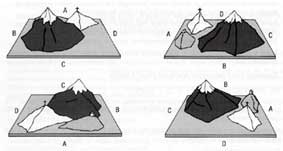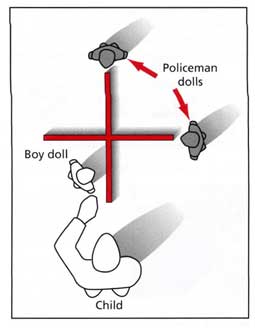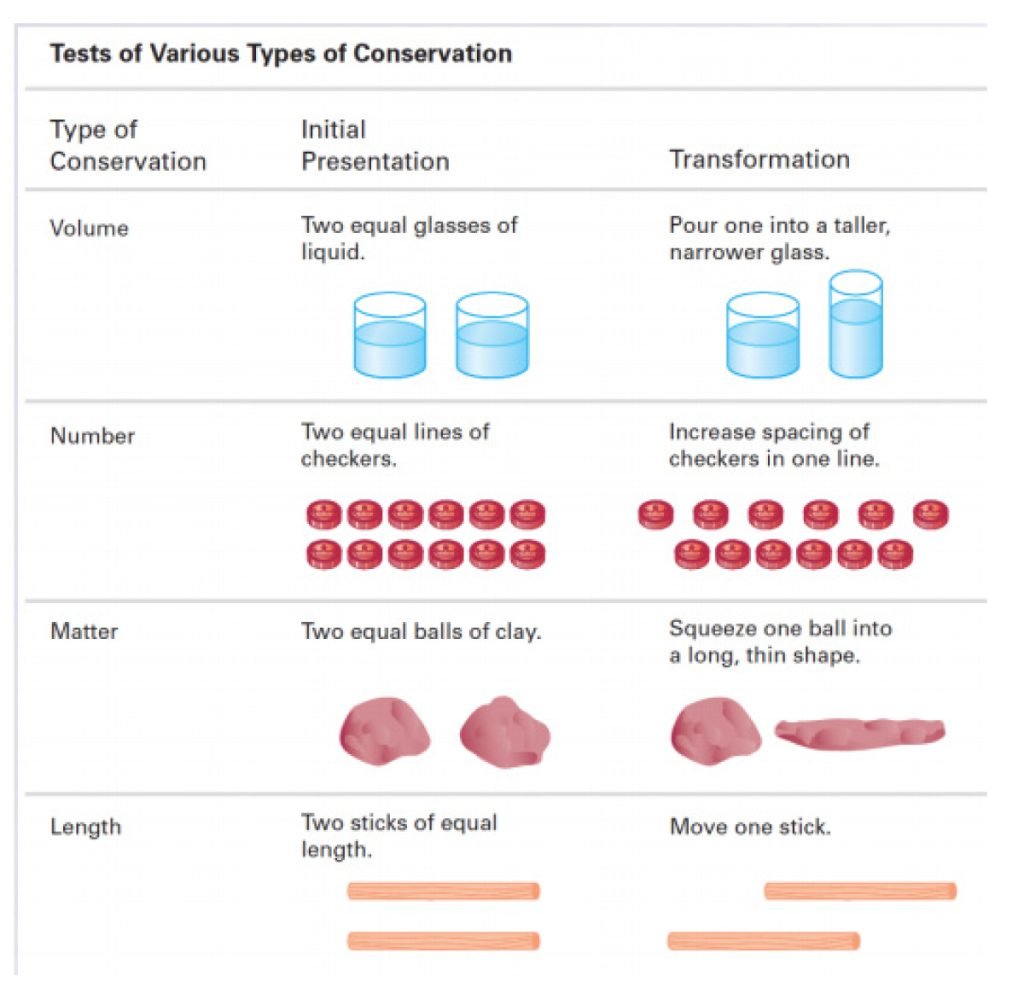On This Page:
Piaget’s preoperational stage is the second stage of his theory of cognitive development. It begins around age two and lasts until approximately age seven. During this stage, children can think symbolically and engage in make-believe play. However, their thinking is still egocentric and lacks logic.
The child’s thinking during this stage is pre- (before) cognitive operations. This means the child cannot use logic, transform, combine, or separate ideas (Piaget, 1951, 1952).
The child’s development consists of building experiences about the world through adaptation and working towards the (concrete) stage when it can use logical thought.
During the end of this stage, children can mentally represent events and objects (the semiotic function), and engage in symbolic play.
Key Features
Centration
Centration is the tendency to focus on only one aspect of a situation at one time. When a child can focus on more than one aspect of a situation, at the same time, they have the ability to decenter.
During this stage, children have difficulties thinking about more than one aspect of any situation at the same time; and they have trouble decentering in social situation just as they do in non-social contexts.
Egocentrism
Egocentrism refers to the child’s inability to see a situation from another person’s point of view. The egocentric child assumes that other people see, hear, and feel exactly the same as the child does.
In the developmental theory of Jean Piaget, this is a feature of the preoperational child. Childrens” thoughts and communications are typically egocentric (i.e., about themselves).
Play
At the beginning of this stage, you often find children engaging in parallel play. That is to say, they often play in the same room as other children but they play next to others rather than with them.
Each child is absorbed in their own private world, and speech is egocentric. That is to say the main function of speech at this stage is to externalize the child’s thinking rather than to communicate with others.
As yet, the child has not grasped the social function of either language or rules.
Symbolic Representation
The early preoperational period (ages 2-3) is marked by a dramatic increase in children’s use of the symbolic function.
This is the ability to make one thing – a word or an object – stand for something other than itself. Language is perhaps the most obvious form of symbolism that young children display.
However, Piaget (1951) argues that language does not facilitate cognitive development, but merely reflects what the child already knows and contributes little to new knowledge. He believed cognitive development promotes language development, not vice versa.
Pretend (or symbolic) Play
Toddlers often pretend to be people they are not (e.g. superheroes, policeman), and may play these roles with props that symbolize real life objects. Children may also invent an imaginary playmate.
“In symbolic play, young children advance upon their cognitions about people, objects and actions and in this way construct increasingly sophisticated representations of the world” (Bornstein, 1996, p. 293).
As the pre-operational stage develops egocentrism declines and children begin to enjoy the participation of another child in their games and “lets pretend “ play becomes more important.
For this to work, there is going to be a need for some way of regulating each child’s relations with the other and out of this need we see the beginnings of an orientation to others in terms of rules.
Animism
This is the belief that inanimate objects (such as toys and teddy bears) have human feelings and intentions. By animism Piaget (1929) meant that for the pre-operational child the world of nature is alive, conscious and has a purpose.
Piaget has identified four stages of animism:
- Up to the ages 4 or 5 years, the child believes that almost everything is alive and has a purpose.
- During the second stage (5-7 years) only objects that move have a purpose.
- In the next stage (7-9 years), only objects that move spontaneously are thought to be alive.
- In the last stage (9-12 years), the child understands that only plants and animals are alive.
Artificialism
This is the belief that certain aspects of the environment are manufactured by people (e.g., clouds in the sky).
Irreversibility
This is the inability to reverse the direction of a sequence of events to their starting point.
The Three Mountains Task
Jean Piaget used the three mountains task (see picture below) to test whether children were egocentric. Egocentric children assume that other people will see the same view of the three mountains as they do.
According to Piaget, at age 7, thinking is no longer egocentric, as the child can see more than their own point of view.
Aim: Piaget and Inhelder (1956) wanted to find out at what age children decenter – i.e. become no longer egocentric.
Method: A child is shown a display of three mountains; the tallest mountain is covered with snow. On top of another are some trees, and on top of the third is a church. The child stands on one side of the display, and there is a doll on the other side of it.
The child was allowed to walk round the model, to look at it, then sit down at one side. A doll is then placed at various positions on the table.
The child is shown pictures of the scene from different viewpoints and asked to select the view that best matched what the doll can “see”.

The child is then shown 10 photographs of the mountains taken from different positions, and asked to indicate which showed the doll’s view.
Piaget assumed that if the child correctly picked out the card showing the doll’s view, s/he was not egocentric. Egocentrism would be shown by the child who picked out the card showing the view s/he saw.
Findings – Typically a four years old child reports what can be seen from her perspective and not what can be seen from the doll’s perspective.
Six years old were more aware of other viewpoints but still tended to choose the wrong one. This shows egocentrism as the child assumed that the doll “saw” the mountains as he did
Four year-olds almost always chose a picture that represented what they could see and showed no awareness that the doll’s view would be different from this.
Six year-olds frequently chose a picture different from their own view but rarely chose the correct picture for the doll’s point of view. Only seven- and eight-year-olds consistently chose the correct picture.
Conclusion – At age 7, thinking is no longer egocentric as the child can see more than their own point of view.
Evaluation – It has been suggested that Piaget’s tasks at this stage may have underestimated the child’s abilities due to a number of factors, including complicated language, unfamiliar materials, lack of context, and children misinterpreting the experimenter’s intention.
More recent studies have attempted to ask questions more clearly and to present situations to which children can relate
more easily.
Critical Evaluation
Policeman Doll Study

Martin Hughes (1975) argued that the three mountains task did not make sense to children and was made more difficult because the children had to match the doll’s view with a photograph.
Hughes devised a task which made sense to the child. He showed children a model comprising two intersecting walls, a “boy” doll and a “policeman” doll. He then placed the policeman doll in various positions and asked the child to hide the boy doll from the policeman.
Hughes did this to make sure that the child understood what was being asked of him, so if s/he made mistakes they were explained and the child tried again. Interestingly, very few mistakes were made.
The experiment then began. Hughes brought in a second policeman doll, and placed both dolls at the end of two walls, as shown in the illustration above.
The child was asked to hide the boy from both policemen, in other words he had to take account of two different points of view.
Hughes” sample comprised children between three and a half and five years of age, of whom 90 percent gave correct answers. Even when he devised a more complex situation, with more walls and a third policeman, 90 percent of four-year-olds were successful.
This shows that children have largely lost their egocentric thinking by four years of age, because they are able to take the view of another.
Hughes” experiment allowed them to demonstrate this because the task made sense to the child, whereas Piaget’s did not. Suggesting that differences in “meaning” children ascribe to situation might cause them to pass or fail task.
The ‘Turntable’ Task
In Borke’s (1975) test of egocentrism the child is given two identical models of a three-dimensional scene (several different scenes were used including different arrangements of toy people and animals and a mountain model similar to Piaget and Inhelder’s). One of the models is mounted on a turntable so
it can easily be turned by the child.
After a practice session where the child is familiarized with the materials and the idea of looking at things from another person’s point of view, a doll is introduced (in Borke’s study it was the character Grover from ‘Sesame Street’, a programme the children were familiar with).
The Grover doll was placed so it was ‘looking’ at the model from a particular vantage point and the child was invited to turn the other model around until its view of the model matched what Grover would be able to see.
Borke (1975) found, using the ‘mountains’ model three-year-olds selected a correct view 42% of the time and four-year-olds selected the right view 67% of the time. With other displays, the three-years-olds accuracy increased to 80% and the four-year olds’ to 93%.
Limitations in the Child’s Thinking
Piaget focused most of the description of this stage on limitations in the child’s thinking, identifying a number of mental tasks which children seem unable to do.
These include the inability to decenter, conserve, understand seriation (the inability to understand that objects can be organized into a logical series or order) and to carry out inclusion tasks.
Children in the preoperational stage are able to focus on only one aspect or dimension of problems (i.e. centration). For example, suppose you arrange two rows of blocks in such a way that a row of 5 blocks is longer than a row of 7 blocks.
Preoperational children can generally count the blocks in each row and tell you the number contained in each. However, if you ask which row has more, they will likely say that it is the one that makes the longer line, because they cannot simultaneously focus on both the length and the number. This inability to decenter contributes to the preoperational child’s egocentrism.

Conservation is the understanding that something stays the same in quantity even though its appearance changes. To be more technical, conservation is the ability to understand that redistributing material does not affect its mass, number or volume.
The ability to solve this and other “conservation” problems signals the transition to the next stage.
So, what do these tasks tell us about the limitations of preoperational thought in general?
Piaget drew a number of related conclusions:
- Understanding of these situations is “perception bound”. The child is drawn by changes in the appearance of the materials to conclude that a change has occurred.
- Thinking is “centered” on one aspect of the situation. Children notice changes in the level of water or in the length of clay without noticing that other aspects of the situation have changed simultaneously.
- Thinking is focused on states rather than on transformations. Children fail to track what has happened to materials and simply make an intuitive judgment based on how they appear “now”.
- Thinking is “irreversible” in that the child cannot appreciate that a reverse transformation would return the material to its original state. Reversibility is a crucial aspect of the logical (operational) thought of later stages.
Frequently Asked Questions
Are there any specific educational strategies that can support children in the preoperational stage?
Here are some educational strategies for children in the preoperational stage (ages 2-7):
1) Use hands-on activities and materials;
2) Encourage pretend play for problem-solving;
3) Utilize visual aids like pictures and charts;
4) Break tasks into smaller steps;
5) Foster language development through conversations and storytelling.
These strategies make learning enjoyable and accessible, supporting cognitive growth during this stage.
How does the preoperational stage differ from the sensorimotor stage?
The preoperational stage and the sensorimotor stage are two distinct stages in Piaget’s theory of cognitive development.
In the sensorimotor stage, infants explore and learn about the world through their senses and motor actions. They develop object permanence and begin to coordinate their senses with their movements.
In contrast, the preoperational stage marks the advancement of symbolic thinking, language development, and pretend play. Children in this stage show egocentrism and struggle with logical reasoning.
Are there any cultural variations in the manifestation of the preoperational stage?
Yes, there are cultural variations in the manifestation of the preoperational stage. Cultural beliefs, values, and practices influence children’s experiences and interactions, which can impact their cognitive development.
For example, cultural differences in parenting styles, educational practices, and social expectations can shape the development of language, symbolic play, and social cognition during the preoperational stage.
Cultural variations may affect the emphasis placed on certain skills, the types of play activities encouraged, and the ways in which children are socialized, leading to differences in cognitive development across cultures.
What are the implications of the preoperational stage for social and emotional development?
During the preoperational stage, social and emotional development undergo significant changes. Children become increasingly aware of their own emotions and the emotions of others.
They begin to engage in cooperative play and develop friendships. However, egocentrism can affect their ability to take others’ perspectives and regulate their emotions effectively.
The emergence of language and symbolic play provides avenues for expressing emotions and understanding social roles.
Positive social interactions and nurturing relationships during this stage contribute to the development of social skills, empathy, and emotional self-regulation, laying the foundation for healthy social and emotional development in later stages.
References
Borke, H. (1975). Piaget’s mountains revisited: Changes in the egocentric landscape. Developmental Psychology, 11(2), 240.
Piaget, J. (1929). The child’s concept of the world. Londres, Routldge & Kegan Paul.
Piaget, J. (1951). Egocentric thought and sociocentric thought. J. Piaget, Sociological studies, 270-286.
Piaget, J., & Cook, M. T. (1952). The origins of intelligence in children. New York, NY: International University Press.
Piaget, J., & Inhelder, B. (1956). The Child’s Conception of Space. London: Routledge & Kegan Paul.
Hughes, M. (1975). Egocentrism in preschool children. Unpublished doctoral dissertation. Edinburgh University.
Tamis-LeMonda, C. S., & Bornstein, M. H. (1996). Variations in Children’s Exploratory, Nonsymbolic, and Symbolic Play: An Explanatory Multidimensional Framework. Advances in infancy research, 10, 37-78.

